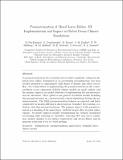Parameterization of mixed layer eddies. III: Implementation and impact in global ocean climate simulations
Author(s)
Fox-Kemper, B.; Danabasoglu, G.; Griffies, S.M.; Hallberg, R.W.; Holland, M.M.; Maltrud, Mathew; Peacock, S.; Samuels, B.L.; Ferrari, Raffaele; ... Show more Show less
DownloadFerrari_Parameterization of mixed.pdf (2.044Mb)
PUBLISHER_CC
Publisher with Creative Commons License
Creative Commons Attribution
Terms of use
Metadata
Show full item recordAbstract
A parameterization for the restratification by finite-amplitude, submesoscale, mixed layer eddies, formulated as an overturning streamfunction, has been recently proposed to approximate eddy fluxes of density and other tracers. Here, the technicalities of implementing the parameterization in the coarse-resolution ocean component of global climate models are made explicit, and the primary impacts on model solutions of implementing the parameterization are discussed. Three global ocean general circulation models including this parameterization are contrasted with control simulations lacking the parameterization. The MLE parameterization behaves as expected and fairly consistently in models differing in discretization, boundary layer mixing, resolution, and other parameterizations. The primary impact of the parameterization is a shoaling of the mixed layer, with the largest effect in polar winter regions. Secondary impacts include strengthening the Atlantic meridional overturning while reducing its variability, reducing CFC and tracer ventilation, modest changes to sea surface temperature and air–sea fluxes, and an apparent reduction of sea ice basal melting.
Date issued
2010-09Department
Massachusetts Institute of Technology. Department of Earth, Atmospheric, and Planetary SciencesJournal
Ocean Modelling
Publisher
Elsevier
Citation
Fox-Kemper, B., G. Danabasoglu, R. Ferrari, S.M. Griffies, R.W. Hallberg, M.M. Holland, M.E. Maltrud, S. Peacock, and B.L. Samuels. “Parameterization of Mixed Layer Eddies. III: Implementation and Impact in Global Ocean Climate Simulations.” Ocean Modelling 39, no. 1–2 (January 2011): 61–78.
Version: Author's final manuscript
ISSN
14635003